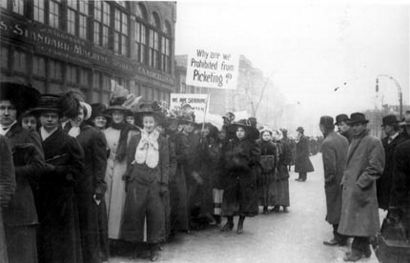1910 Chicago garment workers' strike facts for kids
The 1910 Chicago garment workers' strike was a big protest by workers in the clothing industry. It's also known as the Hart, Schaffner and Marx (HSM) strike. This strike was special because women led it, and workers from different backgrounds came together. They were upset about low pay, too much work, and bad working conditions.
The strike started on September 22, 1910. A 17-year-old named Hannah Shapiro led sixteen women who were protesting. They were unhappy because a new bonus system made them work harder but cut their pay. Soon, many more workers joined. At its peak, about 41,000 workers stopped working.
The United Garment Workers (UGW) union first supported the strike. But they later stopped their support in December 1910. The strike ended when a deal was made in January 1911. This deal was between a worker leader named Sidney Hillman and the HSM company. Even though some workers kept protesting until February 18, the strike helped workers get better pay and conditions. They also got contracts that were managed by a "Rate Committee."
Why Workers Striked
Between 1880 and 1920, many worker protests happened. This was because working conditions, how workers were treated, and their pay were often unfair. The clothing industry grew a lot in Chicago. By 1910, it was the city's third-largest employer. It was also the biggest employer of women.
Before this strike, similar protests happened in other cities. For example, the Uprising of the 20,000 happened in New York City. Strikes also took place in Cleveland and Philadelphia. Women wanted fair treatment. They often did the same work as men but got paid less or received fewer benefits.
How the Strike Unfolded
The strike began on September 22, 1910. Sixteen women, led by Hannah Shapiro, protested against the Hart, Schaffner, Marx company. They were upset about a bonus system that seemed unfair and a cut in their "piece rate." A piece rate means you get paid for each item you make.
The protest grew very quickly. By the end of the first week, 2,000 women had joined. The strike reached its biggest point when the UGW union officially supported it. Then, 41,000 workers walked off their jobs.
Even with UGW support, the union did not call a "general strike." This means not all workers stopped working. The HSM company could still get work done by using workers who were not in a union. This made it harder for the strikers to win.
The UGW stopped supporting the strike in December 1910. Other groups, like the Chicago Federation of Labor and the Women's Trade Union League (WTUL), encouraged workers to make a deal. A deal was finally reached when worker leader Sidney Hillman worked with the HSM company. After four tough months, Hillman helped convince HSM to agree to most of the workers' demands. This included recognizing a new union group and agreeing to solve future problems through "arbitration." Arbitration means an independent person helps solve disagreements.
What Happened After the Strike
The strike was partly successful. Workers gained important support and attention. This led to new rules and agreements in 1911. More new rules were added in 1913 and 1916.
The strike also led to the creation of the Amalgamated Clothing Workers of America union. It also helped start the careers of strike leaders Bessie Abramovitch and Sidney Hillman. They later got married and became very important worker leaders.
Sadly, there were some very difficult incidents during the strike where people were hurt.


